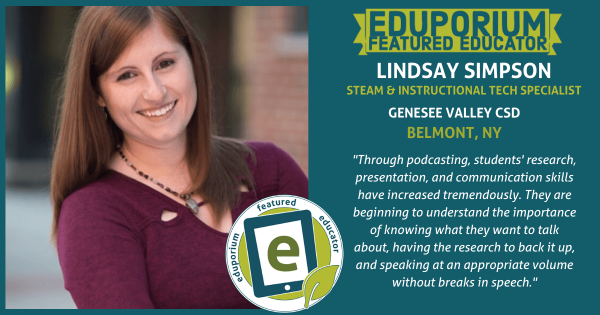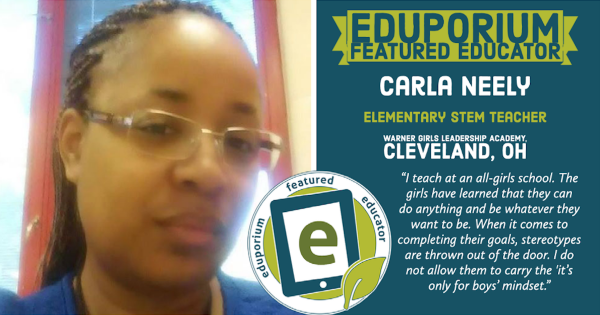Eduporium Featured Educator
Each month, we highlight a committed member from the educator community. From early education through high school, classroom teachers, librarians, administrators, and makerspace facilitators are, unquestionably, the backbone when it comes to providing students with relevant learning experiences. Especially in creating innovative opportunities with technology, we know that those who prioritize student-centered, inquiry-based, and also collaborative learning are doing all they can for children. For that (and other reasons), we launched our Eduporium Featured Educator series to share some successes educators have had. We also wanted to do all we could to help inspire other educators around the country. Each one plays such a vital role in advancing student outcomes and integrating new technology. Ultimately, we hope this leads to teachers trying some new things in the classroom or makerspace.
If you would like to apply to be featured, you can find the application here. We also encourage teachers to share it with colleagues from their schools or district. It can also be a great resource to share throughout your teacher PLN. We believe that the experiences today's educators create are as unique as the students they serve. Since first publishing this series, we have learned a lot about so many creative, compelling, and successful STEM initiatives and projects. The Eduporium Featured Educators—like all others—certainly display true commitment that's second to none. Most importantly, we know their efforts have helped enhance learning experiences for their students. Whether it's in building technology skills, developing soft skills, or increasing their career readiness, creatively integrating technology is something we very much appreciate. And, we continue looking for success stories to share.
-
Eduporium Featured Educator: Andrew McDonald
We’re excited to share our latest Eduporium Featured Educator interview with our community! This month, we hear from Andrew McDonald, who’s an educational consultant and faculty member of the Engineering Secondary School at the University of Ottawa and, like so many other educators around the world, he’s had to get creative over the last year. -
Eduporium Featured Educator: Michelle Robinson
This month, we hear from Michelle Robinson, who’s a library media specialist at the Tackan Elementary School. Michelle has used a bunch of different types of technologies with elementary students in the library. Whether it’s tangible STEM tools or digital creation platforms, Michelle has done a lot to provide students with real-world opportunities. -
Eduporium Featured Educator: Katie Gardner
We’re excited to share our latest Eduporium Featured Educator interview! This month, we hear from Katie Gardner, who’s an elementary ESL teacher in the Rowan-Salisbury School System in North Carolina. Katie has found great benefits from integrating various types of technology in her instruction. She’s even tried using AR tools with her ESL students! -
Eduporium Featured Educator: Lindsay Simpson
Though she and her students have dealt with various challenges during the course of the COVID-19 pandemic, Lindsay has found some creative ways to keep them engaged and developing STEM skills. After starting a student podcast last year and adapting it to the current situation, it ended up being a super valuable piece of the learning her students continue to -
Eduporium Featured Educator: Anna Blake
This month, we hear from Anna Blake, who’s an elementary school technology integration specialist in the Elizabeth Forward School District (PA). Among some of the projects she’s helped lead with her students include combining coding and drones using Swift and challenging students to create programs to pilot their drones! -
Eduporium Featured Educator: Vanessa Haddad
Vanessa has found creative ways to leverage various types of technology in her instruction when working with college students and certainly found that providing students with these hands-on experiences has helped them develop real-world skills through their experiences. Read on to find out more of what’s worked for her! -
Eduporium Featured Educator: Jean Daley
Jean is a paralibrarian at the Erving Public Library in Erving, MA and, like so many others, she’s had to adapt some of the library’s programming to be accessible remotely—something she’s found success with so far by maximizing the resources she has available to her, including her colleagues at the library. -
Eduporium Featured Educator: Carla Neely
As a science teacher, Carla has made use of the STEM framework when it comes to instruction in the classroom. Instead of having her students write a written report on a bridge found somewhere in the world, for example, she found it more engaging to have students use a blueprint and build the bridge that they are researching themselves. -
Eduporium Featured Educator: Jeremy Osborne
This month, we’ve heard from Jeremy Osborne, who’s the Innovative Learning Coordinator for the Berkeley County School District. With a background as an elementary STEM teacher, Jeremy knows all about the kinds of hands-on learning experiences kids want and need and he’s now very much involved in ensuring all students have access to those. -
Eduporium Featured Educator: Jim Hambel
This month, Jim shares his thoughts and experiences with teaching PE remotely and, if not, no worries—you can learn about his creativity in this post as well! Like almost everybody else, Jim had to adapt his teaching style to accommodate distance learning and he definitely found some success with what he tried. Keep reading to learn more about him!













